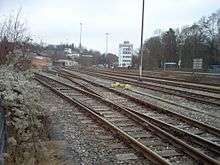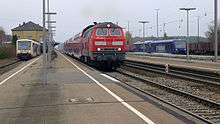Hohenzollerische Landesbahn
|
Logo of the Hohenzollerischen Landesbahn | |
Formerly called | Actiengesellschaft Hohenzollern’sche Kleinbahngesellschaft |
|---|---|
| company | |
| Industry | railways |
| Founded | 1899 in Sigmaringen, Province of Hohenzollern, Prussia |
| Headquarters | Bahnhofstraße 21, Hechingen, Germany |
Area served | Baden-Württemberg |
| Services | Rail passenger and freight operations |
| Revenue | €42.2 million[1] (2012) |
| Owner |
|
Number of employees | 276 (2012) |
| Website | http://www.hzl-online.de/ |
The Hohenzollerische country Bahn AG (HzL) is the largest non-federally owned railway company in the German state of Baden-Württemberg after the Albtal-Verkehrs-Gesellschaft and Südwestdeutsche Verkehrs-Aktiengesellschaft. It has operates passenger and freight traffic since 1900. Its field of activity now extends to large parts of southern Baden-Württemberg.
The focus of its business in 2011, with revenue of €32.4 million (80%), is railway passenger operations, 11% (€4.3 million) of revenues come from road transport bus operations and revenue of €3.6 million (9%) is produced by rail freight operations.
The HzL is a member of the Tarifverband der Bundeseigenen und Nichtbundeseigenen Eisenbahnen in Deutschland ("fare association of federally-owned and non-federally owned railways in Germany", TBNE) and the Verband Deutscher Verkehrsunternehmen ("association of German transport companies").
History

The HzL was founded in 1899 as the Actiengesellschaft Hohenzollern’sche Kleinbahngesellschaft (Hohenzollern light railway company) in order to build Kleinbahn (light railways as authorised by a Prussian law of 1892) in the Prussian region of Sigmaringen (part of the Province of Hohenzollern).
Since the Province of Hohenzollern was an elongated territory partly surrounded by the Kingdom of Württemberg, the Royal Württemberg State Railways’s railway at this time only used the shortest route through this "foreign" area and only served the two district towns of Hechingen (from 1869) and Sigmaringen (from 1878).
As the founder of Hohenzollerischen Landesbahn, the government of Prussia took over 50 percent of the capital, and the Landeskommunalverband der Hohenzollerischen Lande (a collective local government body body of the Province of Hohenzollern) and the Westdeutsche Eisenbahn-Gesellschaft (West German Railway Company) took about 25 percent each. Since 1972, the majority shareholder has been the state of Baden-Württemberg with 71.934%, while Zollernalbkreis and Sigmaringen district each have 14.033%. The HZL in turn holds 7.5% of the share capital of the Verkehrsverbund Neckar-Alb-Donau (Neckar-Alb-Donau transport association, naldo).[2]
The HzL began to build branches from the lines of the Württemberg State Railways to develop the Prussian territory. The first was opened on 28 March 1900 in the Danube Valley, running upstream of Sigmaringendorf through the Lauchert valley to the Laucherthal goods yard at the Fürstlichen steelworks and continuing to Bingen. The following year the HzL brought three more branch lines into operation:
- on 18 March 1901 from Hechingen to Burladingen,
- on 7 June 1901 from Eyach via Haigerloch to Stetten and the Stetten salt mine and
- on 7 November 1901 branching off the Reutlingen–Schelklingen railway at Kleinengstingen and running to Gammertingen.
After a break of several years, during which the company was renamed Hohenzollerische Landesbahn AG on 18 June 1907, four lines were selected for extension as a connected network.
On 6 December 1908, the railway was extended from Burladingen to Gammertingen, which is still the location of the HzL’s operating center with its main workshop, and it continued to the southeast via Hanfertal to Bingen, where it connected with the existing line to Sigmaringendorf on the Danube Valley Railway.
On 5 October 1910, a shortcut was completed from Hanfertal to Sigmaringen state railway station. At Christmas 1912 (24 December) the last gap was closed between Stetten and Hechingen, providing a continuous line from Eyach via Hechingen–Gammertingen–Hanfertal to Sigmaringendorf with a length of 86 km. With the branches to Kleinengstingen (20 km) and to Sigmaringen (2 km), the HzL network comprised a total length of almost 107.4 km, including 15 km of lines in Württemberg.
It was managed by the operations branch, based in Stuttgart, of the Westdeutsche Eisenbahn-Gesellschaft (WeEG) of Cologne until 1928 and following the WeEG’s merger with Aktiengesellschaft für Verkehrswesen, it was managed by the Vereinigte Kleinbahnen. From 1 July 1933, the HzL has managed its operation itself. Its seat of administration is Hechingen.
Development of HzL network

The main line network of the HzL, which was completed almost a hundred years ago, is still in operation today. Passenger services are operated between Hechingen and Sigmaringen, continuing to Eyach on Saturdays, Sundays and public holidays. The rest of the network was converted to bus operations between 1968 and 1973 section by section:
- 29 September 1968: Sigmaringendorf–Bingen–Hanfertal (school trains continued until 30 May 1991)
- 1 June 1969: Kleinengstingen–Trochtelfingen
- 28 May 1972: Trochtelfingen–Gammertingen
- 1 October 1972: Eyach–Haigerloch
- 3 June 1973: Haigerloch–Hechingen
The HzL bus services launched in 1947 today cover an 800-km route network with hubs in Reutlingen, Horb, Sigmaringen and Riedlingen.
In 2000, the Gammertingen–Kleinengstingen railway was reactivated for excursion trips of the Rad-Wander-Shuttle, running from May to October, supporting cycling tourism.
The 107.5 km long main line of the HzL was extended in January 2001 by the leasing of the 12.9 km-long non-dismantled section of the DB-owned Balingen–Rottweil railway between Balingen and Schomberg. This line is used by HzL freight traffic and is also served by the Rad-Wander-Shuttle during the summer. In addition, the HzL operates on behalf of the Ringzug the 2.8 km-long Bräunlingen–Hüfingen section of the Breg Valley Railway, which was originally owned by the Südwestdeutsche Verkehrs-Aktiengesellschaft.
The main lines of the HzL
Eyach–Hechingen line
| Eyach–Hechingen railway (ZAB 4) | |||||||||||||||||||||||||||||||||||||||||||||||||||||||||||||||||||||||||||||||||||||||||||||||||||||||||||||||||||||||||||||||||||||||||||||||||||||||||||||||||||||||||||||||||||||||||||||||||||||||||||||||||||||||||||||||||||||||||||||||||||||||||||||||||||||||||||||||||||||||||||||||||||||||||||
|---|---|---|---|---|---|---|---|---|---|---|---|---|---|---|---|---|---|---|---|---|---|---|---|---|---|---|---|---|---|---|---|---|---|---|---|---|---|---|---|---|---|---|---|---|---|---|---|---|---|---|---|---|---|---|---|---|---|---|---|---|---|---|---|---|---|---|---|---|---|---|---|---|---|---|---|---|---|---|---|---|---|---|---|---|---|---|---|---|---|---|---|---|---|---|---|---|---|---|---|---|---|---|---|---|---|---|---|---|---|---|---|---|---|---|---|---|---|---|---|---|---|---|---|---|---|---|---|---|---|---|---|---|---|---|---|---|---|---|---|---|---|---|---|---|---|---|---|---|---|---|---|---|---|---|---|---|---|---|---|---|---|---|---|---|---|---|---|---|---|---|---|---|---|---|---|---|---|---|---|---|---|---|---|---|---|---|---|---|---|---|---|---|---|---|---|---|---|---|---|---|---|---|---|---|---|---|---|---|---|---|---|---|---|---|---|---|---|---|---|---|---|---|---|---|---|---|---|---|---|---|---|---|---|---|---|---|---|---|---|---|---|---|---|---|---|---|---|---|---|---|---|---|---|---|---|---|---|---|---|---|---|---|---|---|---|---|---|---|---|---|---|---|---|---|---|---|---|---|---|---|---|---|---|---|---|---|---|---|---|---|---|---|---|---|---|---|---|---|---|
| Overview | |||||||||||||||||||||||||||||||||||||||||||||||||||||||||||||||||||||||||||||||||||||||||||||||||||||||||||||||||||||||||||||||||||||||||||||||||||||||||||||||||||||||||||||||||||||||||||||||||||||||||||||||||||||||||||||||||||||||||||||||||||||||||||||||||||||||||||||||||||||||||||||||||||||||||||
| Locale | Baden-Württemberg, Germany | ||||||||||||||||||||||||||||||||||||||||||||||||||||||||||||||||||||||||||||||||||||||||||||||||||||||||||||||||||||||||||||||||||||||||||||||||||||||||||||||||||||||||||||||||||||||||||||||||||||||||||||||||||||||||||||||||||||||||||||||||||||||||||||||||||||||||||||||||||||||||||||||||||||||||||
| Technical | |||||||||||||||||||||||||||||||||||||||||||||||||||||||||||||||||||||||||||||||||||||||||||||||||||||||||||||||||||||||||||||||||||||||||||||||||||||||||||||||||||||||||||||||||||||||||||||||||||||||||||||||||||||||||||||||||||||||||||||||||||||||||||||||||||||||||||||||||||||||||||||||||||||||||||
| Line length | 27.9 km (17.3 mi) | ||||||||||||||||||||||||||||||||||||||||||||||||||||||||||||||||||||||||||||||||||||||||||||||||||||||||||||||||||||||||||||||||||||||||||||||||||||||||||||||||||||||||||||||||||||||||||||||||||||||||||||||||||||||||||||||||||||||||||||||||||||||||||||||||||||||||||||||||||||||||||||||||||||||||||
| Track gauge | 1,435 mm (4 ft 8 1⁄2 in) standard gauge | ||||||||||||||||||||||||||||||||||||||||||||||||||||||||||||||||||||||||||||||||||||||||||||||||||||||||||||||||||||||||||||||||||||||||||||||||||||||||||||||||||||||||||||||||||||||||||||||||||||||||||||||||||||||||||||||||||||||||||||||||||||||||||||||||||||||||||||||||||||||||||||||||||||||||||
| Route number | 9460 | ||||||||||||||||||||||||||||||||||||||||||||||||||||||||||||||||||||||||||||||||||||||||||||||||||||||||||||||||||||||||||||||||||||||||||||||||||||||||||||||||||||||||||||||||||||||||||||||||||||||||||||||||||||||||||||||||||||||||||||||||||||||||||||||||||||||||||||||||||||||||||||||||||||||||||
| |||||||||||||||||||||||||||||||||||||||||||||||||||||||||||||||||||||||||||||||||||||||||||||||||||||||||||||||||||||||||||||||||||||||||||||||||||||||||||||||||||||||||||||||||||||||||||||||||||||||||||||||||||||||||||||||||||||||||||||||||||||||||||||||||||||||||||||||||||||||||||||||||||||||||||


Heavy trains hauled by locomotives cannot be operated on the Stetten (bei Haigerloch)–Weißes Kreuz section.
In the autumn of 2008, the HzL resumed the operation of classic railway passenger services, as distinct from excursion trains In 2009, after an absence of 30 years. Leisure traffic was operated as the 3-Löwen-Takt Radexpress Eyachtäler in 2009 and gradually expanded. Since 2012, it runs on Sundays and public holidays from 1 May to the 3rd Sunday in October. This involves a railcar shuttling at 2-hour intervals between Eyach and Hechingen Landesbahn (timetable route 767). Until 2011, it was operated mainly with a historical MAN Schienenbus (railbus), which was replaced from 2012 by a modern Regio-Shuttle. Further trips have been run every year for the Haigerloch Christmas market. The HzL foresees future timetables having a 30-minute interval service to connect with tourist traffic from the metropolitan region of Stuttgart on the Stuttgart–Hattingen railway.[4]
Hechingen–Gammertingen line
| Hechingen–Gammertingen railway (ZAB 2) | |||||||||||||||||||||||||||||||||||||||||||||||||||||||||||||||||||||||||||||||||||||||||||||||||||||||||||||||||||||||||||||||||||||||||||||||||||||||||||||||||||||||||||||||||||||||||||||||||||||||||||||||||||||||||||||||||||||||||||||||||||||||||||||||||||||||||||||||||||||||||||||||||||||||||||||||||||||||||||||||
|---|---|---|---|---|---|---|---|---|---|---|---|---|---|---|---|---|---|---|---|---|---|---|---|---|---|---|---|---|---|---|---|---|---|---|---|---|---|---|---|---|---|---|---|---|---|---|---|---|---|---|---|---|---|---|---|---|---|---|---|---|---|---|---|---|---|---|---|---|---|---|---|---|---|---|---|---|---|---|---|---|---|---|---|---|---|---|---|---|---|---|---|---|---|---|---|---|---|---|---|---|---|---|---|---|---|---|---|---|---|---|---|---|---|---|---|---|---|---|---|---|---|---|---|---|---|---|---|---|---|---|---|---|---|---|---|---|---|---|---|---|---|---|---|---|---|---|---|---|---|---|---|---|---|---|---|---|---|---|---|---|---|---|---|---|---|---|---|---|---|---|---|---|---|---|---|---|---|---|---|---|---|---|---|---|---|---|---|---|---|---|---|---|---|---|---|---|---|---|---|---|---|---|---|---|---|---|---|---|---|---|---|---|---|---|---|---|---|---|---|---|---|---|---|---|---|---|---|---|---|---|---|---|---|---|---|---|---|---|---|---|---|---|---|---|---|---|---|---|---|---|---|---|---|---|---|---|---|---|---|---|---|---|---|---|---|---|---|---|---|---|---|---|---|---|---|---|---|---|---|---|---|---|---|---|---|---|---|---|---|---|---|---|---|---|---|---|---|---|---|---|---|---|---|---|---|---|---|---|---|---|---|---|---|---|---|---|---|---|---|
| Technical | |||||||||||||||||||||||||||||||||||||||||||||||||||||||||||||||||||||||||||||||||||||||||||||||||||||||||||||||||||||||||||||||||||||||||||||||||||||||||||||||||||||||||||||||||||||||||||||||||||||||||||||||||||||||||||||||||||||||||||||||||||||||||||||||||||||||||||||||||||||||||||||||||||||||||||||||||||||||||||||||
| Line length | 27.0 km (16.8 mi) | ||||||||||||||||||||||||||||||||||||||||||||||||||||||||||||||||||||||||||||||||||||||||||||||||||||||||||||||||||||||||||||||||||||||||||||||||||||||||||||||||||||||||||||||||||||||||||||||||||||||||||||||||||||||||||||||||||||||||||||||||||||||||||||||||||||||||||||||||||||||||||||||||||||||||||||||||||||||||||||||
| Track gauge | 1,435 mm (4 ft 8 1⁄2 in) standard gauge | ||||||||||||||||||||||||||||||||||||||||||||||||||||||||||||||||||||||||||||||||||||||||||||||||||||||||||||||||||||||||||||||||||||||||||||||||||||||||||||||||||||||||||||||||||||||||||||||||||||||||||||||||||||||||||||||||||||||||||||||||||||||||||||||||||||||||||||||||||||||||||||||||||||||||||||||||||||||||||||||
| Route number | 9466 | ||||||||||||||||||||||||||||||||||||||||||||||||||||||||||||||||||||||||||||||||||||||||||||||||||||||||||||||||||||||||||||||||||||||||||||||||||||||||||||||||||||||||||||||||||||||||||||||||||||||||||||||||||||||||||||||||||||||||||||||||||||||||||||||||||||||||||||||||||||||||||||||||||||||||||||||||||||||||||||||
| |||||||||||||||||||||||||||||||||||||||||||||||||||||||||||||||||||||||||||||||||||||||||||||||||||||||||||||||||||||||||||||||||||||||||||||||||||||||||||||||||||||||||||||||||||||||||||||||||||||||||||||||||||||||||||||||||||||||||||||||||||||||||||||||||||||||||||||||||||||||||||||||||||||||||||||||||||||||||||||||

Kleinengstingen–Sigmaringen line
| Kleinengstingen–Sigmaringen railway | |||||||||||||||||||||||||||||||||||||||||||||||||||||||||||||||||||||||||||||||||||||||||||||||||||||||||||||||||||||||||||||||||||||||||||||||||||||||||||||||||||||||||||||||||||||||||||||||||||||||||||||||||||||||||||||||||||||||||||||||||||||||||||||||||||||||||||||||||||||||||||||||||||||||||||||||||||||||||||||||||||||||||||||||||||||||||||||||||||||||||||||||||||||||||||||||||||||||||||||||||||||||||||||||||||||||||||||||||||||||
|---|---|---|---|---|---|---|---|---|---|---|---|---|---|---|---|---|---|---|---|---|---|---|---|---|---|---|---|---|---|---|---|---|---|---|---|---|---|---|---|---|---|---|---|---|---|---|---|---|---|---|---|---|---|---|---|---|---|---|---|---|---|---|---|---|---|---|---|---|---|---|---|---|---|---|---|---|---|---|---|---|---|---|---|---|---|---|---|---|---|---|---|---|---|---|---|---|---|---|---|---|---|---|---|---|---|---|---|---|---|---|---|---|---|---|---|---|---|---|---|---|---|---|---|---|---|---|---|---|---|---|---|---|---|---|---|---|---|---|---|---|---|---|---|---|---|---|---|---|---|---|---|---|---|---|---|---|---|---|---|---|---|---|---|---|---|---|---|---|---|---|---|---|---|---|---|---|---|---|---|---|---|---|---|---|---|---|---|---|---|---|---|---|---|---|---|---|---|---|---|---|---|---|---|---|---|---|---|---|---|---|---|---|---|---|---|---|---|---|---|---|---|---|---|---|---|---|---|---|---|---|---|---|---|---|---|---|---|---|---|---|---|---|---|---|---|---|---|---|---|---|---|---|---|---|---|---|---|---|---|---|---|---|---|---|---|---|---|---|---|---|---|---|---|---|---|---|---|---|---|---|---|---|---|---|---|---|---|---|---|---|---|---|---|---|---|---|---|---|---|---|---|---|---|---|---|---|---|---|---|---|---|---|---|---|---|---|---|---|---|---|---|---|---|---|---|---|---|---|---|---|---|---|---|---|---|---|---|---|---|---|---|---|---|---|---|---|---|---|---|---|---|---|---|---|---|---|---|---|---|---|---|---|---|---|---|---|---|---|---|---|---|---|---|---|---|---|---|---|---|---|---|---|---|---|---|---|---|---|---|---|---|---|---|---|---|---|---|---|---|---|---|---|---|---|---|---|---|---|---|---|---|---|---|---|---|---|---|---|---|---|---|---|---|---|---|---|---|---|---|---|---|---|---|---|---|---|---|---|---|
| Technical | |||||||||||||||||||||||||||||||||||||||||||||||||||||||||||||||||||||||||||||||||||||||||||||||||||||||||||||||||||||||||||||||||||||||||||||||||||||||||||||||||||||||||||||||||||||||||||||||||||||||||||||||||||||||||||||||||||||||||||||||||||||||||||||||||||||||||||||||||||||||||||||||||||||||||||||||||||||||||||||||||||||||||||||||||||||||||||||||||||||||||||||||||||||||||||||||||||||||||||||||||||||||||||||||||||||||||||||||||||||||
| Line length | 42.9 km (26.7 mi) | ||||||||||||||||||||||||||||||||||||||||||||||||||||||||||||||||||||||||||||||||||||||||||||||||||||||||||||||||||||||||||||||||||||||||||||||||||||||||||||||||||||||||||||||||||||||||||||||||||||||||||||||||||||||||||||||||||||||||||||||||||||||||||||||||||||||||||||||||||||||||||||||||||||||||||||||||||||||||||||||||||||||||||||||||||||||||||||||||||||||||||||||||||||||||||||||||||||||||||||||||||||||||||||||||||||||||||||||||||||||
| Track gauge | 1,435 mm (4 ft 8 1⁄2 in) standard gauge | ||||||||||||||||||||||||||||||||||||||||||||||||||||||||||||||||||||||||||||||||||||||||||||||||||||||||||||||||||||||||||||||||||||||||||||||||||||||||||||||||||||||||||||||||||||||||||||||||||||||||||||||||||||||||||||||||||||||||||||||||||||||||||||||||||||||||||||||||||||||||||||||||||||||||||||||||||||||||||||||||||||||||||||||||||||||||||||||||||||||||||||||||||||||||||||||||||||||||||||||||||||||||||||||||||||||||||||||||||||||
| Route number | 9461 | ||||||||||||||||||||||||||||||||||||||||||||||||||||||||||||||||||||||||||||||||||||||||||||||||||||||||||||||||||||||||||||||||||||||||||||||||||||||||||||||||||||||||||||||||||||||||||||||||||||||||||||||||||||||||||||||||||||||||||||||||||||||||||||||||||||||||||||||||||||||||||||||||||||||||||||||||||||||||||||||||||||||||||||||||||||||||||||||||||||||||||||||||||||||||||||||||||||||||||||||||||||||||||||||||||||||||||||||||||||||
| |||||||||||||||||||||||||||||||||||||||||||||||||||||||||||||||||||||||||||||||||||||||||||||||||||||||||||||||||||||||||||||||||||||||||||||||||||||||||||||||||||||||||||||||||||||||||||||||||||||||||||||||||||||||||||||||||||||||||||||||||||||||||||||||||||||||||||||||||||||||||||||||||||||||||||||||||||||||||||||||||||||||||||||||||||||||||||||||||||||||||||||||||||||||||||||||||||||||||||||||||||||||||||||||||||||||||||||||||||||||

Sigmaringendorf–Hanfertal line
| Sigmaringendorf–Hanfertal line | |||||||||||||||||||||||||||||||||||||||||||||||||||||||||||||||||||||||||||||||||||||||||||||||||||||||||||||||||||||||||||||||||||||||||||||||||||||||||||||||||||||||||||||||||||||||||||
|---|---|---|---|---|---|---|---|---|---|---|---|---|---|---|---|---|---|---|---|---|---|---|---|---|---|---|---|---|---|---|---|---|---|---|---|---|---|---|---|---|---|---|---|---|---|---|---|---|---|---|---|---|---|---|---|---|---|---|---|---|---|---|---|---|---|---|---|---|---|---|---|---|---|---|---|---|---|---|---|---|---|---|---|---|---|---|---|---|---|---|---|---|---|---|---|---|---|---|---|---|---|---|---|---|---|---|---|---|---|---|---|---|---|---|---|---|---|---|---|---|---|---|---|---|---|---|---|---|---|---|---|---|---|---|---|---|---|---|---|---|---|---|---|---|---|---|---|---|---|---|---|---|---|---|---|---|---|---|---|---|---|---|---|---|---|---|---|---|---|---|---|---|---|---|---|---|---|---|---|---|---|---|---|---|---|---|---|
| Technical | |||||||||||||||||||||||||||||||||||||||||||||||||||||||||||||||||||||||||||||||||||||||||||||||||||||||||||||||||||||||||||||||||||||||||||||||||||||||||||||||||||||||||||||||||||||||||||
| Line length | 9.7 km (6.0 mi) | ||||||||||||||||||||||||||||||||||||||||||||||||||||||||||||||||||||||||||||||||||||||||||||||||||||||||||||||||||||||||||||||||||||||||||||||||||||||||||||||||||||||||||||||||||||||||||
| Track gauge | 1,435 mm (4 ft 8 1⁄2 in) standard gauge | ||||||||||||||||||||||||||||||||||||||||||||||||||||||||||||||||||||||||||||||||||||||||||||||||||||||||||||||||||||||||||||||||||||||||||||||||||||||||||||||||||||||||||||||||||||||||||
| Route number | 9462 | ||||||||||||||||||||||||||||||||||||||||||||||||||||||||||||||||||||||||||||||||||||||||||||||||||||||||||||||||||||||||||||||||||||||||||||||||||||||||||||||||||||||||||||||||||||||||||
| |||||||||||||||||||||||||||||||||||||||||||||||||||||||||||||||||||||||||||||||||||||||||||||||||||||||||||||||||||||||||||||||||||||||||||||||||||||||||||||||||||||||||||||||||||||||||||
Expansion on the lines of other railways



Over the past 20 years, the field of activity of the Hohenzollerischen Landesbahn has significantly expanded.
In freight operations, since 1990, the HzL has taken over the hauling of salt block trains from Stetten (b Haigerloch) on DB lines to Ulm. The HzL also hauls freight on flat wagon between Tübingen, Sigmaringen, Bad Saulgau and Schelklingen in cooperation with Deutsche Bahn (DB Cargo).
Its passenger operations now operate over a route network of more than 400 kilometres. From 1993, the HzL took over the operation of the Bodensee-Oberschwaben-Bahn, which now runs between Aulendorf and Friedrichshafen. In 1997, the HzL received a contract from the State of Baden-Württemberg for the operation of Regionalbahn services on the Tübingen–Sigmaringen railway, Danube Valley Railway and Herbertingen–Aulendorf railway, forming the Zollernalb Railway between Tübingen and Aulendorf.
Since September 2003, it has operated the Ringzug in the Schwarzwald-Baar-Heuberg region; this is an S-Bahn-like transport system connecting Blumberg, Tuttlingen, Rottweil, Villingen-Schwenningen and Donaueschingen, for which the Verkehrsbetrieb Ringzu branch was built with its own management and depot. The most recent expansion took place on Lake Constance: in December 2006, it over operations under a new contract of the 17 kilometre-long route of the Seehäsle service over the Stockach–Radolfzell line from SBB GmbH, the German subsidiary of the Swiss Federal Railways.
The HzL also hauls passenger trains for Deutsche Bahn (DB Regio) on the Rottweil–Horb and Tübingen–Herrenberg routes. The railcars and locomotives the HzL are regularly hired out for special trains and work trains throughout Baden-Württemberg and Switzerland.
References
- ↑ Annual financial statements for fiscal year from 1 January 2012 to 31 December 2012. 20 February 2014.
- ↑ Karlheinz Fahlbusch (3 August 2011). "Landkreis vielfach finanziell engagiert". Südkurier (in German).
- 1 2 3 4 Eisenbahnatlas Deutschland (German railway atlas). Schweers + Wall. 2009. ISBN 978-3-89494-139-0.
- ↑ Dietmar Schindler (16 January 2014). "Neuer Fahrplan für die Gäubahn". Schwarzwälder Bote (in German). Oberndorf. Retrieved 21 June 2016.
Sources
- Michael Kochems; Frank von Meißner (2004). Regionalbahnen im Südwesten: HzL, SWEG, AVG und WEG auf ihrem Weg in die Zukunft (in German). Düsseldorf: ALBA-Verlag. ISBN 3-87094-240-1.
- Botho Walldorf (2007). Die Hohenzollerische Landesbahn in den 1960er-Jahren (in German) (2 ed.). Erfurt: Sutton Verlag. ISBN 978-3-86680-125-7.
- "KBS 768". Das große Archiv der Eisenbahnstrecken (in German). GeraMond.
- Günter Zieger (1999). 100 Jahre HzL. Geschichte der Hohenzollerischen Landesbahn AG. 1899 - 1999 (in German). HzL.
- Guido Motika (2004). "3.b.-f.". Schienen an der Zollernalb (in German). 3. Self-published on order.
External links
| Wikimedia Commons has media related to Hohenzollerische Landesbahn. |
- "Hohenzollerische Landesbahn website" (in German). Retrieved 21 June 2016.
- "HZL line 9460" (in German). Die Tunnelportale. Retrieved 21 June 2016.
- "HZL line 9461" (in German). Die Tunnelportale. Retrieved 21 June 2016.
- "HZL line 9466" (in German). Die Tunnelportale. Retrieved 21 June 2016.
- "Rolling stock list" (in German). www.privat-bahn.de. Retrieved 21 June 2016.
